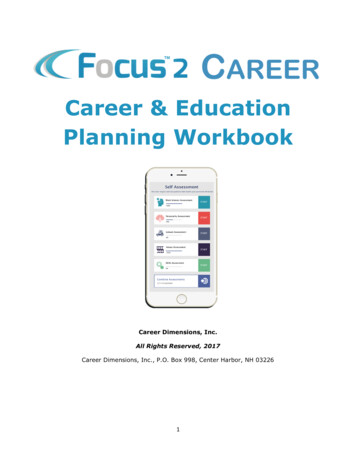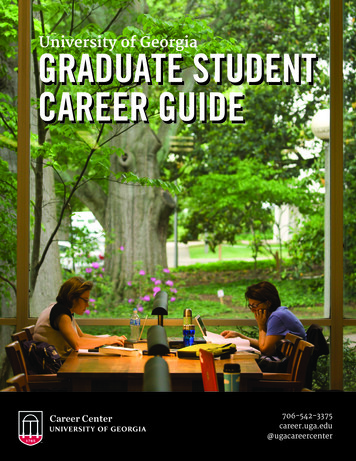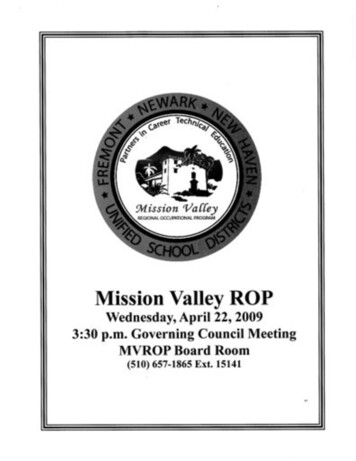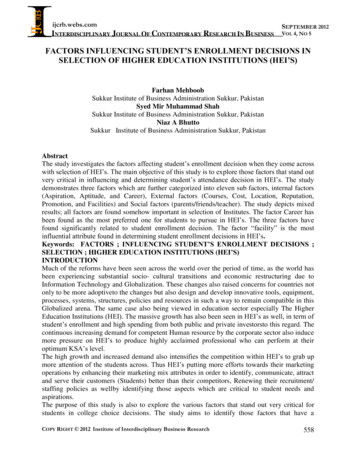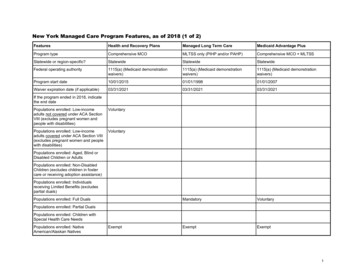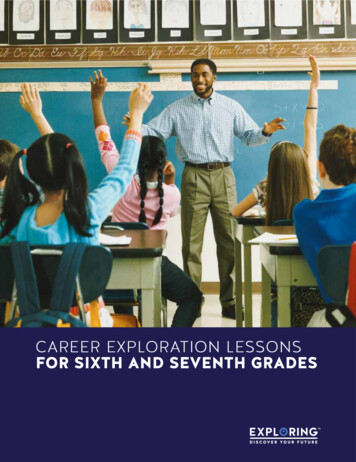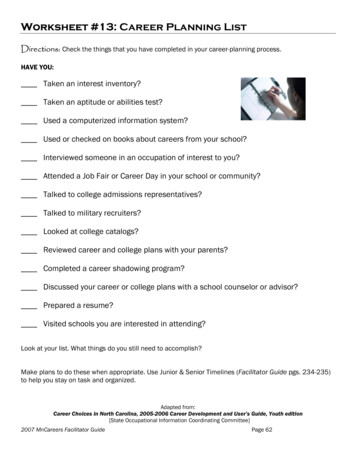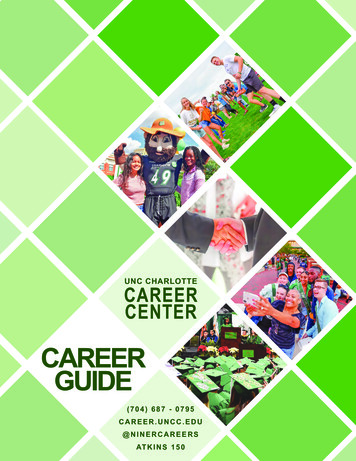
Transcription
Career Choice Factors 1CAREER CHOICE FACTORS OF HIGH SCHOOL STUDENTSByMichael BorchertA Research PaperSubmitted in Partial Fulfillment of theRequirements for theMaster of Science DegreeWith a Major inCareer and Technical EducationApproved: 2 Semester CreditsInvestigation AdvisorThe Graduate CollegeUniversity of Wisconsin-StoutDecember, 2002
Career Choice Factors 2The Graduate SchoolUniversity of Wisconsin-StoutMenomonie, WI 54751Abstract(Writer)Borchert(Last Name)Michael(First)T.(Initial)Career Choice Factors(Title)Vocational Education(Graduate Major)Dr. Michael Galloy(Research Advisor)December/2002(Month/Year)82(No. of Pages)American Psychological Association (APA)(Name of Style Manual Used in this Study)Many factors affect career choices of high school students. Identifying thesefactors would give parents, educators, and industry an idea as to where students placemost of their trust in the career selection process. It would also allow students to examineprocesses they use for career selection. The literature review has provided recommendedmodels in career choices. The review of the literature showed that three areas of astudent’s life affect the career choices they make: environment, opportunity, andpersonality. All three played varying roles in career outcomes. This study attempted toidentify to what extent these factors played a role in career choice and which were mostimportant. Data was collected from seniors at Germantown High School, using a surveyform. Specific objectives of the study were the following:1) How influential were factors of personality in making career choices?2) How influential were factors of the environment in making career choices?3) How influential were the factors of opportunities in career choice?
Career Choice Factors 34) Which areas of personality, environment, or opportunity were most importantto the students?The study’s significance of the study includes the following:1) Some students do not begin to explore ‘real’ career possibilities until after highschool graduation. Technical colleges might more aggressively inform students earlier intheir schooling, of information, knowledge, and skills they could apply to their dailystudies.2) Some students do not seriously consider many alternative choices in careerselection. Sources of influence, such as parents or mentors, could be brought into a circleof counseling and discussion to help the student form a comprehensive career plan oroutline.3) Industry could see where, why, and when it could be beneficial for them toinvest resources for the purpose of training, while still in technical schools.4) If career planning were done in an efficient manner, students would at the veryleast be following a career plan of informed decision-making, rather than one ofhappenstance.The researcher will analyze the collected information and identify any existingtrends. In addition, he will suggest and explore implications and recommendations.
Career Choice Factors 4ACKNOWLEDGEMENTSIn my search for knowledge and experience in life, I am reminded more and morejust how lucky I have been. This paper in particular and my degree in general would nothave been possible if not for the reassurance and help I got along the way. Gayle, mywife, never doubted me; she gave me the support I needed to accomplish what I onlyenvisioned. Gayle is truly my inspiration. My daughters, Megan and Corie, understoodwhat this undertaking meant for their dad and helped out immensely, both in spirit and intaking up the slack around the house. I hope their life endeavors will meet with the sameloving guidance. Mrs.Diedrich, an educator our entire family has known through theyears, gave me the courage to see that the trip was worth the journey. Mrs. Barnes, SusanWolff, and the Germantown High School staff helped me attain the goal I started out forin choosing the topic I did. I thank Moraine Park Technical College of West Bend forgiving me all the support a student could need in the field of adult education. This topicwas dear to me in several ways. If just one student sees how career choice is one of themost important life decisions he or she will ever make, the work will have paid off.The friends I have made not only as instructors, but also truly as life advisors willassist me throughout my lifelong endeavors. I was truly fortunate to have Dr. MikeGalloy as my first and last instructor and advisor for this paper. His balance as aninstructor is a talent and a gift I can only hope to emulate in any instructional capacity Ipursue. Dr. Galloy has helped me find stability in my studies many times, when I thoughtI was lost. Thank you, Mike. Dr. Amy Gillett, you showed me that learning any subject ispossible. With the attitude you possess as an instructor, students cannot lose. I willalways be reminded of that. I thank the entire staff of the UW-Stout campus, including
Career Choice Factors 5the library staff, for time spent there and through distance learning. The StoutCommunity has given another student a lifelong friend.
Career Choice Factors 6TABLE OF CONTENTSTITLE PAGE .1ABSTRACT .2ACKNOWLEDGEMENTS .4TABLE OF CONTENTS .6LIST OF TABLES . .9CHAPTER ONE – Introduction 11Factors in Career Choice .11Statement of Problem .16Purpose of the Study .16Research Questions 16Significance of the Study . .17Assumptions .17Limitations .18Definitions .18Summary 19CHAPTER TWO – Introduction .20Environment .20Opportunities .24Personality. 35Summary 40CHAPTER THREE – Introduction 42Description of Methodology .42
Career Choice Factors 7Research Design .42Pilot Studies .43Description and Selection of Subjects .43Instrumentation .44Data Collection .44Instructions to Subjects .45Data Analysis .45Summary 45CHAPTER FOUR – Introduction .46Demographics 47Research Question One .53Research Question Two .55Research Question Three .59Research Question Four .62Responses to Survey’s Open Questions .64CHAPTER FIVE – Introduction 66Discussion of Research Question One .66Discussion of Research Question Two .67Discussion of Research Question Three 69Discussion of Research Question Four .71Student’s Career Choice Options .73Conclusions and Recommendations for Further Study . 74REFERENCES .76
Career Choice Factors 8APPENDICES . .80Consent Form . .81Student Survey .82
Career Choice Factors 9LIST OF TABLESTable 1: Gender . 47Table 2: Birth Order Within Family . .48Table 3: Highest Education Level of Both Parents 49Table 4: Time Spent Researching Career Choices . .49Table 5: Grade Started Thinking About Career Choices . .50Table 6: Grade Point Average . .51Table 7: Students Receiving a Paycheck . .52Table 8: I Have Definitely Made a Career Choice 53Table 9: Environmental Factors Do Affect Career Choices . .54Table 10: Opportunity Factors Do Affect Career Choices 56Table 11: Personality Factors Do Affect Career Choices .56Table 12:. . . 57Table 13 .57Table 14 .58Table 15 . .58Table 16 . .59Table 17: Personality Factors Do Affect Career Choices . . . .60Table 18 .60Table 19 .61Table 20 .61Table 21 . .62Table 22 . .62
Career Choice Factors 10Table 23: Student’s Comparison Of The Career Choice Factors- Environment,Opportunity, and Personality .63
Career Choice Factors 11CHAPTER ONEIntroductionCareer selection is one of many important choices students will make indetermining future plans. This decision will impact them throughout their lives. Theessence of who the student is will revolve around what the student wants to do with theirlife-long work. Basavage (1996, p.1) in her thesis asked, “What is it that influenceschildren one way or another?” Over the school’s front door at Rindge School ofTechnical Arts is the saying, “Work is one of our greatest blessings. Everyone shouldhave an honest occupation” (Rosenstock & Steinberg, cited in O’Brien, 1996, p. 3).Every student carries the unique history of their past and this determines how they viewthe world. That history created, in part by the student’s environment, personality, andopportunity, will determine how students make career choices. It then follows that howthe student perceives their environment, personality, and opportunity also will determinethe career choices students make.Factors in Career ChoiceThe first factor in career choice, environment, may influence the career studentschoose. For example, students who have lived on an island may choose a career dealingwith the water, or they may choose to leave the island behind, never to have anything todo with water again. Maybe someone in the student’s life has made a significant impactor impression, leading to a definite career choice. Parents’ educational background mayinfluence student views on whether or not to continue their education. Someone they sawon television may have influenced the student, or parents may have demanded that they
Career Choice Factors 12assume a family business. These are various environmental factors that would lead astudent to a chosen career.How students have seen themselves in a role in which personality is a determiningfactor may influence a chosen career. Some careers demand that you have the personalityto match the qualities of the occupation. For example, sales people have to be outgoing.Splaver (1977) said “personality” plays an important role in the choosing of the rightcareer. A student’s personality must be a self-motivated type, as to investigate careerpossibilities from early on in their lives, and not the procrastinating type that waits untilthey are compelled to decide. Students must take seriously the role grades play in limitingopportunities in the future. Splaver went on to say, “It is important for you to have a goodunderstanding of yourself, your personality, if you are to make intelligent career plans”(Splaver, 1977, p.12).Opportunity is the third factor that has shaped career choices for students.Opportunity may influence how students have perceived their future in terms of thereasonable probability of a future in particular career fields. The issue of poverty hasplayed an important determining role in the opportunities available to all. The incomelevel of high school families may determine what career a student chooses during aspecific time in the student’s life; choices that will determine a large part of that student’sfuture. Some students will have to budget education according to their personal income.Thout (1969) addressed those in desperate need, “Where necessary, these persons[Individuals described as living under the poverty level] must be assisted through specialtraining programs to overcome educational and social handicaps so that minimum jobstandards can be met” (p. 1). Students in many cases will need the proper mentoring
Career Choice Factors 13opportunities to succeed. These support groups will be another opportunity that ifproperly implemented, can help a student in the career choice process. The supportsystem must have been in place and readily available for the student to utilize. Thecreation of support groups will have to be in place to sustain the student through times offinancial, emotional, and educational need.In a dissertation by Thomas O’Brien (1996), the subjects were based on casestudies of six different high school students ‘interested’ in enrolling into a program titledWorkbound. Workbound is considered an opportunity only available to some studentsduring their high school experience. The perceptions of these students upon entering astructured cooperative work program varied from “eager” to “skeptical and suspicious” to“a resume builder.” Students see the world in many different ways according to O’Brien.The various views were described in the interviews that took place duringimplementation of that Workbound program. Opportunities that students pointed out inthese interviews motivated students to pursue future career choices with every one oftheses students. These motivational values will affect them for the rest of their lives. Theperceptions and eventual decisions these students made were based on the microcosm ofthe previous opportunities during the first seventeen to eighteen years of their lives.These formative years include the history from which students draw, to make decisionsconcerning the rest of their lives. That is not to say there isn’t a time later on in life formodifying and re-grouping; however, this will not come without cost.In an attempt to see how students took advantage and followed through onopportunities, the researcher interviewed University Wisconsin-Stout’s Assistant Directorof Admissions, Barbara Tuchel, who indicated that students take the path of least
Career Choice Factors 14resistance to enter the University. If a parent had exerted enough pressure on the studentto enter a particular career field and the student had no current plans, then studentsfollowed their parents’ suggestion. Tuchel thought that students should be thinking aboutcareer decisions in their senior year of high school. It should become apparent at that timethat the student will have to do something. Tuchel stated that the environment plays alarge part in a student’s career choice. Students traditionally stay at home to either obtaineducation or start employment. Tuchel mentioned that marriage also played a large partin career decisions. She stated that the economics of marriage either solidified thecommitment to go on to higher education or stopped career plans short, depending on thestability of the marriage (B.J.Tuchel, personal communication, June 18, 2002). Examplessuch as these are opportunities that can play a large determining factor in student’s careerchoice.The researcher chose Germantown High School (GHS) as the research studyarea. GHS is located in a suburb northwest of Milwaukee, Wisconsin. There are 1,250students attending GHS, grades nine through twelve (Germantown, 2002). High schoolseniors of this school should already have started to make decisions on career choices.These choices will be based on perceptions of their environment, their opportunities, andtheir perceived personalities.Environmental determinants in Germantown have included the economics of thestudent’s neighborhood. Germantown’s students have access to academic, technical,public and private colleges in the area. Other environmental determinants would includerecreational facilities and articles the student has seen in local papers or on the television.
Career Choice Factors 15The student’s support sytem made up of parents, relatives, siblings, peers, teachers, andcounselors may be the most environmental factor.Industry provided many opportunities for the students of GHS in the local area. Inan interview with the researcher, Mr. Kenneth Heines, president of KLH Industries inGermantown, stated that he wished there would be a more ongoing effort to motivate,educate, and direct students in the direction of the machine trades. He felt that studentswere not being told on an equal basis, by career counselors, the success stories of those inthe trade at present; compared to those that pursued a traditional four year collegeprofession. Some of his employees had at one time floundered in a previous career.Eventually frustration took these students down the path of investigating the technicaltrades more thoroughly. With the education they received at the technical college, alongwith the support of business, they then attained a much better quality of life than before(K.L. Heines, personal communications, May, 2002).Educational opportunities for high school seniors at Germantown High Schoolinclude the Wisconsin State College system, many private colleges, and three technicalcolleges, including Milwaukee Area Technical College (MATC), Waukesha CountyTechnical College (WCTC), and Moraine Park Technical College (MPTC). There is arich diversity of jobs available, from manufacturing, service, health, military, and the fullgamut of professional positions. MATC is the technical college that students fromGermantown High School would most likely attend upon graduation. MATC boasts acurriculum that offers 150 associate degrees, and that students could benefit from careerplanning, counseling, and employment development through career counseling at(Milwaukee Area Technical College, 2002). The students at Germantown High School
Career Choice Factors 16are likely to have considered MATC in their exploration to determine a career path.MATC should be considering GHS students as potential students, getting information tothe high school students ready to graduate. As we can see, there are many opportunitiesor paths to be explored by high school students. High school seniors will haveaccomplished choosing a career choice if a complete, thoughtful, educated decision wasmade evaluating all of the factors possible in career choice process.Statement of the problemThere is no clear process that students at Germantown High School have used tomake career choices. Students at Germantown High School should have the opportunityto explore all of the choices available in order to make a logical, educated plan whenchoosing a career.Purpose of the studyThe three major areas affecting career choice were environment, opportunity andpersonality. The purpose of the study was to identify the most important factor withinthese three factors that 2002 Germantown High School senior students used in decidingupon career choices. Identification of these factors obtained through a survey instrumentwill assist in the dissemination of information to Germantown High School studentsutilizing factors that students have chosen.Research questionsThe questions of the research were the following:1) How significant were factors of the environment in making career choices?2) How significant were factors of opportunity in making career choices?3) How significant were factors of personality in making career choices?
Career Choice Factors 174) Which factor, environment, opportunity, or personality, was most significantto students at Germantown High School?Significance of the studyThe significance of the study was as follows:1) Some students did not begin to explore ‘real’ career possibilities until aftergraduation. Academic colleges, technical colleges, industry, and armed forces couldprovide students with relevant information earlier in their schooling. They could be moreaggressive, giving students information they could test and use in their daily studies andapply to their career choice.2) Before graduating, some students have not considered enough alternativechoices in career selection to justify making an informed decision. Sources of influencesuch as parents or mentors could be brought into a circle of counseling and discussion, tohelp the student form a comprehensive career plan or outline.3) Industry could examine where, why, and when it could be beneficial for themto invest resources to train and educate students.4) If career planning were implemented in an efficient manner, students would atthe very least be following a career plan of informed decision-making, rather than one ofhappenstance.AssumptionsAssumptions of the study were as follows:1) That students want to have control over their career choices.2) That at any level of endeavor, students have taken the issue of career choice, tobe one of the most important facts determining the quality of life.
Career Choice Factors 183) When answering the surveys, students have given honest answers.LimitationsLimitations of the study included the following:1) While the size of the study was large enough to conclude reasonableassumptions, the sample data was obtained from one senior class in one high school in aparticular geographic location and may not have been indicative of the larger population.Validity of the survey has relied on the students’ genuine and thoughtful response.DefinitionsFor clarity the terms used in the study were defined as follows:Career choice – The broad opportunities that exists for life long vocations. Thesevocations are set out in a framework of strategies moving toward personal goals. Fieldsof vocational, academic, and sociological endeavors are explored for the purpose ofsatisfying personal, economic, and intellectual goals.Environment – The complex physical factors that make up our surroundings(Britannica, 2002), and in turn act upon us. For the purposes of this study they wouldinclude the forces of family, political, social, and economic issues that both typical andnon-typical students may deal with on a day-to-day basis.Motivation – Forces acting on or within a person causing an initiation of behavior(Britannica 2002) or what it is that moves us. In this study we will deal with the issuesthat help or hinder students in making career choices.Opportunity – Those choices in one’s life which are exposed either in a subtle orobvious manner. These choices or paths give the individual a selection between two or
Career Choice Factors 19more outcomes. The outcomes of one’s choosing may or may not exceed one’s presentabilities.Personality – A characteristic way of thinking, feeling and behaving (Britannica,2002). The personality is the collection of impressions in the appearance of the student’sbody and the impressions believed to have been made on others, good or bad.One’s personality may embrace attitudes and opinions that affect the way we deal withinteractions of people and, in particular to this study, the situations of choosing a career.Quality of life – The depth in the content of richness and fullness in our dayto-day existence. This includes observed and unobserved criteria that contribute to thefulfillment with our expectations and aspirations.SummaryExploration of career choices should be a positive endeavor for high schoolstudents. A thoughtfully constructed career choice process will provide a meaningful,productive, satisfying quality of career choices. A career choice process or outline mightprovide better answers than making life decisions based upon 18 years of experience.This study has explored how and when input into the career decision process could makea positive impact.
Career Choice Factors 20CHAPTER TWOLiterature ReviewIntroductionThis chapter reviews the literature that described the student career choiceprocess. The body of literature available for review encompassed many volumes.Therefore, this review of the literature focused on 1) how environments in which studentsfind themselves have lead them in a particular direction, 2) how opportunities might haveinfluenced a student’s career choice, and 3) why the perceptions of one’s personality mayhave determined the route they took in their career choice process.EnvironmentThroughout a career, an individual seeks to accommodate the environment withone’s goals, while at the same time being incorporated into the environment (Kroll,Dinklage, Lee, Morley, & Wilson, 1970). Career development is the balancing ofrecognizing and meeting needs of the individual while at the same time responding to theouter forces and realities of life. Career decision factors involve two sets of input: the selfand the world of work. The individual in a career has constantly balanced one’saspirations and how they have fitted into the reality of the workplace. “Man’s occupationdetermines the kind of person he becomes since, through his waking hours, his cognitionsabout himself, his wants and goals, and his interpersonal response traits are molded”(Kroll et al., 1970, p. 19). Kroll went on to say that much of the informal and formalknowledge provided through our society and our environment has focused on theacquisition, retention, and utilization of information pertaining to the world. We haveobserved that both the self and the world emerge as important factors in the constructs
Career Choice Factors 21that we have attained, in that they have become the important features in the acquisition,retention, and translation of information about one’s self (Kroll et al., 1970).Environment plays a significant role in the career position the student attains inmany ways. The environment that is spoken about here is a factor that is used to nurturedecisions in career choice. Gender, for example has played a significant role in thisenvironment. In a statement released to the press on the thirtieth anniversary of the TitleIX barring of the sex discrimination, Marcia Greenberger (2002) of the NationalWomen’s Law Center stated that boys are still being steered toward the traditional ‘male’jobs, which are higher paying. Girls are still expected to cluster into the traditional fieldsof cosmetology, childcare, and other similar jobs. In Florida for example, “99% of thestudents in cosmetology are female, while 100% of the students taking plumbing aremale” (Greenberger, 2002, p. 2). While it should be noted that lawsuits were filed inthese cases, not all states were guilty of gross failure on the part of technical school todesegregate the jobs to both of the genders.Schools in some states have been able to do a better job in creating a betterenvironment for students who want to cross gender lines while choosing a career. Skillspresent in males and females alike have been indicative of their vocational interests.Grace Laleger, in her Ph.D. dissertation, set out to ascertain the skill levels of girls asthey applied to interests that the girls had. The conclusion showed that there was adisappointingly low correlation of skills to interest (Laleger, 1942). These types ofstudies have shown how difficult it is to break the code of motivation that students maypossess. The fact that Laleger’s study was done in 1942 shows that gender bias, and the
Career Choice Factors 22study of it, is nothing new, and may continue to be an always-present part of the careerchoice process.One means of prompting students to participate in the career choice planning is amandate to require Southern California’s San Fernando Valley, District C’s students tosubmit a description of their plans for some postsecondary education or training to schoolofficials; or at least explain their future career paths in detail. Under this first-year trialpolicy, the graduates have to spell out those goals, which could include college, tradeschool, the military, or other options, even if they have not met the requirement tograduate (Cavanagh, 2002). The intent of the career explanation was to have studentswith low expectations talk with counselors about options for advancing their careers inthe future.However it has been shown that counselors cannot ‘do it all.’ In a chapter titled“Career counseling realities” (Weiler, 1977, p. 50), Weiler discussed what counselors canand cannot do. Counselors can draw career preferences to the forefront, in reflecting ofstudent preferences, clarifying career preferences, summarizing, and encouraging studentcareer preferences. Counselors should not be engaged with the evaluation for example,telling the student what they are or are not capable of doing. Counselors should notmoralize or tell the student what they should do, what their motives should be, orpersuade the student to adopt a different point of view. Career counselors are ineffectiveif they try to dictate, judge, or decide the student’s values. And finally, counselors shouldnot make predictions that go beyond the capability of their training (Weiler, 1977).For students to provide themselves with answers to career choice questions,decision-making has become a tool to form career choices. Kroll (Kroll et al., 1970) cited
Career Choice Factors 23Super’s own research, which indicates that the decision making process concerning one’scareer is not so much a function of the information amassed to the individual, but morethe process of maturity and planning. Kroll cites Clarke, Gelatt, and Levine in which theystressed that good decision-making relied upon adequate information and effectivestrategies for making choice.Students can help themselves in to decide myth from reality, communication, andlearning to operate autonomously, are fundamental building blocks used in effectivecareer planning. In order to succeed in obtaining their goals, students must know whatthey want. “Too many of us have been taught to suppress what we want and insteadconcentrate on meeting other people’s expectations. In doing this we end up spendingmost of our ti
taking up the slack around the house. I hope their life endeavors will meet with the same loving guidance. Mrs.Diedrich, an educator our entire family has known through the years, gave me the courage to see that the trip was worth the journey. Mrs. Barnes, Susan Wolff, and the Germantown High
